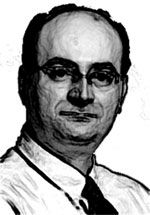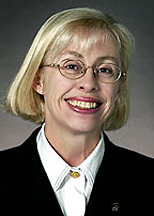- Thoughts on the future of electronics
- Vice-president, external relations resigns
- Editor:
- Chris Redmond
- Communications and Public Affairs
- credmond@uwaterloo.ca
To reach the Daily Bulletin
When and where
The “Future Warriors” UW girls’ hockey camp runs to Friday in the Columbia Icefield Arena.
Columbia Lake Village residents will be visiting Toronto this Saturday, 8:30 a.m.-8 p.m. Tickets are $10 at the CLV front desk.
Columbia Lake Village kids are invited to share in outdoor fun and games, Saturday. Meet at the community centre at 2 p.m.
Hot water shut down in all buildings inside the ring road, as well as Village I, August 23-24 (12:01 a.m. Wednesday to 4 p.m. Thursday).
TRACE office closed August 23 and 24.
Thoughts on the future of electronics
Things are getting simpler and more complicated at the same time, judging from comments made by one expert on the web site of UW’s Centre for Learning and Teaching Through Technology this month.
 The current LT3 “spotlight” reports some musings on the impact of technology on students’ learning experiences, from a conversation with Koorus Bookan (left), LT3’s Computer Systems Analyst (Learning and Innovation Technology). “We were talking,” it says, “about all of the technologies that aid students for learning (in and out of class), now and in the very near future. We talked not only emerging hardware technology, but also the network and communication developments that are changing the way that people use these technologies.”
The current LT3 “spotlight” reports some musings on the impact of technology on students’ learning experiences, from a conversation with Koorus Bookan (left), LT3’s Computer Systems Analyst (Learning and Innovation Technology). “We were talking,” it says, “about all of the technologies that aid students for learning (in and out of class), now and in the very near future. We talked not only emerging hardware technology, but also the network and communication developments that are changing the way that people use these technologies.”
Says the unidentified author of the profile: “Koorus surprised me when he told me that Asia leads the world in the use of the newest technology, followed closely by Europe, and then next by North America. He observed that we are all moving fast, but that we all have different priorities. However, in post secondary Education, North America certainly is in a completely different race.
“The combination of wireless technology and mobile computing is resulting in escalating transformations of the educational world. The question is not if, but, how, are the wireless, mobile technologies affecting learning environment, pedagogy, and campus life?
“Koorus, for example, pointed out that over the last 20-30 years hardware vendors have been stuffing more features into every device to satisfy everyone’s desires. This convergence of features seemed to work for the designers and manufacturers. But in his role, Koorus hears many people wishing for a simpler device – one that is easy to use, with a very simple interface. So, as new hybrid video cell phones, which download content for students to hear and watch labs/lectures, and hear their favourite tunes, as well as upload their answers to simple questions/polls in class or in homework, are created, simplicity and ease-of-use need to be at the forefront for designers.”
Bookan also points to the difference between first year students over the next five years and those who preceded them. “These upcoming first year students will be quite sophisticated – many will have Palm Treos and RIM Blackberrys, and other sophisticated products such as iPods. They will expect highly sophisticated electronics that support their interacting with information, which can include learning content. So, we need to keep an eye on the changing needs of our students and work with them as well, to integrate the best learning technology for the maximum impact of benefit. We must carefully examine the wireless, mobile learning experience as it rapidly develops, doing our best to grasp emergent trends. Part of LT3’s mandate is to help support instructors as you try new things, and the FLEX Lab environment is an ideal environment for safe class activity with new approaches.”
Wireless, says Bookan, is to the 21st century what the automobile was to the 20th century: a new form of freedom, an innovative approach to conquering time and space, a powerful industry force, and one of the most important technologies of the century, influencing the nature of business, commerce, education, and society. “From that mighty beginning, think of how much we can do with our students!”
Vice-president, external relations resigns
 President Johnston today informed Executive Council and Governors that he has accepted Laura Talbot-Allan’s resignation. In his notice the President said:
President Johnston today informed Executive Council and Governors that he has accepted Laura Talbot-Allan’s resignation. In his notice the President said:
Laura has indicated that, with the Campaign at over $310 million raised to date, and with the External Relations team well established, she plans to return to consulting along with continued volunteer work and some travel. I have, with regret, accepted her resignation as Vice-President, External Relations.
Until her successor is found, ODAA and External Relations is reporting to me. Lois Claxton, Secretary of the University, will be responsible for Communications and Public Affairs.
I know you will join me in celebrating the great success of our campaign under Laura’s leadership and in wishing her the best in future endeavours.
In discussions with her senior team and a note to her staff in External Relations, Laura said this:
I have been reflecting the last couple of months about the excellent and ahead-of-target results of the Talent Trust Campaign as well as the evolution of External Relations – great progress which will be sustained. So it is timely for me, personally, to make some changes.
I have resigned my position as Vice-President, to take some personal time and will be returning to consulting along with continued volunteer work and some travel. I hope to continue to collaborate as a volunteer on a couple of initiatives in Kitchener-Waterloo and UW that especially touched my heart and, while living in Kingston, will continue to be in K-W frequently due to my business interests and family who live here.
The External Relations team, is strong, committed, and an integral part of UW’s success and national and international reputation. Much has been accomplished over the last 5 years and I’m proud of the great successes we in External Relations, collaborating with many UW champions, have achieved: the capital campaign, several important public / private partnerships and new funding sources, development of the government relations role, establishment of strategic relations with all levels of government, strong relationships fostered with alumni, donors, friends, corporate and government partners as well as local, national and international communities.
I want to thank External Relations team members for their many contributions and to note special thanks to my senior directors who have been very stimulating and supportive individually and collectively.
It has been great to work with the UW community. I have met and collaborated with many stimulating people – champions, volunteers and students. I have especially appreciated the leadership of the President and Chair of the Board and of the Campaign, Bob Harding. We at UW have collectively accomplished a great deal. I am very pleased to have had the opportunity to do so with many of you.
Good luck to all.
Talbot-Allan came to UW in 2001. She had previously held senior positions in the federal government and in the private sector, and had established her own consulting firm.
When Talbot-Allan came, UW’s capital campaign was about to commence and it was her responsibility to build the team and infrastructure not only to support the campaign, but to provide for an ongoing and sustainable development program.
The President has not indicated when the search for a new Vice-President will commence. In the interim, he will oversee ODAA and Government Relations. Lois Claxton, Secretary of the University, will be responsible for Communications and Public Affairs.

